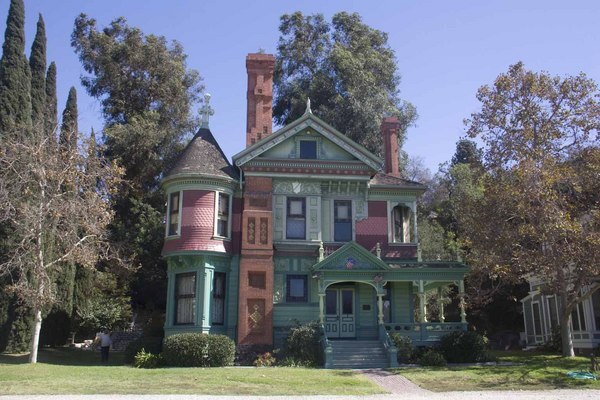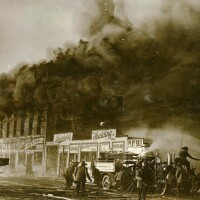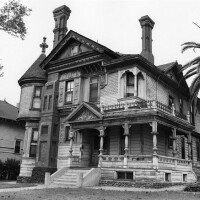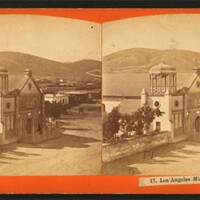Victorian Los Angeles by the Arroyo Seco

It is sometimes difficult to imagine the Los Angeles that was here since 1781, but pieces of that past still exist. Squeezed between the glassy skyscrapers of Bunker Hill and the sleek modernist homes atop Hollywood Hills are blips of Los Angeles's pueblo and Victorian past, for those with eagle eyes. One of these spots lie along the Arroyo Seco just before it merges with the Los Angeles River.
The Heritage Square Museum in Highland Park is a piece of Los Angeles's often-overlooked history. "This is what Los Angeles was when California became a state," said Dana Anderson, President of the Board of Directors for the museum.
The museum was originally formed with the City of Los Angeles, said Jessica Rivas, Education and Volunteer Programs Director for the museum, as we chatted inside one of the Victorian homes. Concerned by the spate of demolitions of more traditional architecture in the 1960s, a group of concerned citizens, which included former Southwest Museum director, Carl Dentzel, banded together to create a new haven for these endangered structures.
With the help of the Los Angeles Cultural Heritage Board (now the Cultural Heritage Commission), the museum found a home on an unused 10-acre parcel of Los Angeles parkland that sits by the Arroy Seco, two miles away from the Arroyo Seco Confluence. "The land still belongs to the Los Angeles Department of Recreation and Parks. We're on a 50-year lease," according to Rivas. Despite its city connections, the museum receives minimal funding from the city and all revenue is garnered from admissions, museum store sales, site rentals and donors.


Unlike the big name museums in Los Angeles, the Heritage Square Museum lies in relative quiet. It sits at the bottom of a hill, on the very end of a cul de sac, where rows and rows of homes face the river. That also meant that the museum is about a 20-minute walk from the nearest Metro train station, the Southwest Museum Station.
(Author's note: Heritage Square Station isn't closer to the museum, as you might expect. A little bit of digging turned up the fact that Metro changed that station's name from French Avenue to Heritage Square/Arroyo Station just a few months before the station was set to open. Hat tip to KCET's own Elson Trinidad.)
Strangely, its location helped its cause. Because of its insulation from the rest of the world (except for the hum of freeway), one could easily believe that nothing existed beyond the museum's gates. As I entered, a long gravel path stretched out before me. On either side, homes from another Los Angeles stood in silence.
Those used to the relative simplicity of modern homes would be pleasantly surprised at the amount of detail in the homes. There are no boxy homes in this collection. Instead there are pitched roofs, gables, mansards, and even steeples. Gone are the beige stucco of Los Angeles's ubiquitous dingbat apartments, replaced with Christmas green and red, corn yellow and sage, and pristine white.

"Los Angeles has a lot of history," says Anderson. "These houses were meant to be destroyed, but that would have been a shame because there's so much craftsmanship wrapped up in them." By giving residents a glimpse of Los Angeles' past, the museum hopes to give locals a sense of Los Angeles as it was when it was just beginning.
Visitors are treated to a guided walking tour of five houses, a carriage barn, train station, and a church in various states of repair, all constructed between 1876 and 1899, moved from different Los Angeles neighborhoods. The museum's most recent addition is a reproduction of an old-time drugstore, with vintage contents from the late 19th century to 1950 donated by the Simmons family.
Guides treat guests to an architectural history of the homes, along with personal tidbits about its inhabitants, just like the juicy tale of Mamie Perry. Mamie was the eldest daughter of William Hayes Perry of the Perry Mansion.
On the outside, the Perry Mansion is a clean white Greek Revival Italianate home, perhaps the most expensive home seen in its Boyle Heights neighborhood when it was built. Inside, the home is speculated to have been the stage for a love triangle between Mamie, Italian tenor Federico Landini, and shy flautist Charles Davis.
Each home had a distinct personality with details that could fascinate endlessly. One of the most striking for me was the Hale House, built in 1887 by George W. Morgan, a land speculator and real estate developer. From its Christmas combination of colors, reproduced from chips of the original, and Oriental doors to the low-relief carvings, I could have taken photographs all day just of the home.

The Hastings-Longfellow Octagon House was Anderson and Rivas's favorite. Built in 1893, Gilbert Longfellow was a veteran Octagon house builder, having constructed his first octagonal home on the coast of Maine. According to Orson S. Fowler, an octagonal home would be superior to the usual four-sided variety because it could offer more windows that allowed more light inside and circulation throughout the rooms. It would also require shorter spans of lumber, which were cheaper to purchase. Unfortunately, Fowler's advocacy for the style died out sometime in the Civil War era. Less than 500 of these homes exist in the country today. Rivas enjoys the home's wrap around veranda. Anderson pointed out that on warm days, opening the windows on the very top of the home could easily cool the home.
Those infected with today's maker zeitgeist would probably appreciate the Ford House the most. The home was built in 1887 alongside a whole tract of middle class homes in downtown Los Angeles. It used to sit between First and Temple streets in downtown Los Angeles. To personalize his home, wood carver John J. Ford, created beautiful carvings that now pepper his home. Every exterior and interior carving was made by hand. Ford's wood works can be found in the California State Capital; the Iolani Palace in Hawaii, which housed the last king and queen of Hawaii; and Leland Stanford's private railroad car.
Though the museum only has nine structures under its care, it hopes to expand even more. But that can't be done without public support, says Anderson. The museum is funded solely through private donations, grants, and admissions. While it ideally could save even more buildings, the museum is constrained by budgets. Moving a building is the easy part, according to Anderson; the harder question is where to find the budget for its restoration. For now, the museum plugs along, working bit by bit on restorations and keeping a piece of a lost Los Angeles alive.
Get an up close look at Heritage Square Museum mansions while indulging in a little historic fantasy with a Victorian Magic show at the Perry Mansion grand parlor. Shows start January 25. Tickets available here.
Photos by Carren Jao


